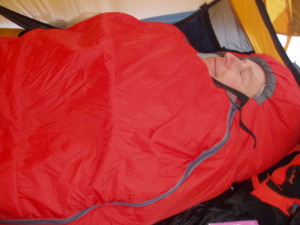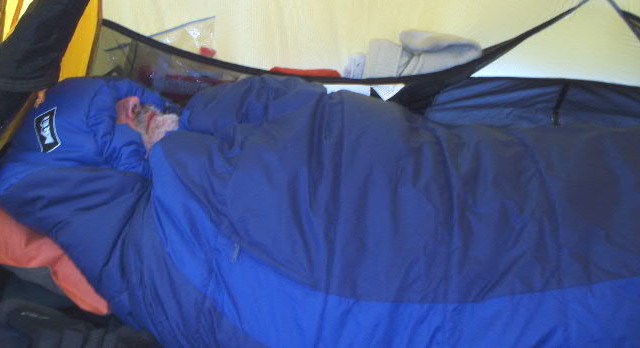
There’s been a lot of hype in the backpacking world about a new sleeping bag testing system called “EN13537“. In it, a manikin with a variety of thermal sensors is put in the sleeping bag, and the bag is then tested for warmth for men and women, with different numbers for comfort and survival ratings. The goal is to allow a buyer to compare bags based on standardized testing, rather than guesswork. We’ve all seen “+32 degree” bags that were miserably cold at 40 degrees…but also some that are comfortable at 25 degrees. Wouldn’t it be nice to know which is which before you’re tucked in on a cold night! That’s the promise of EN13537 sleeping bag testing.
Does EN13537 Sleeping Bag Testing Really Work?
Well…it SOUNDS good…but does it really work? This winter, we tested a pair of identically EN rated REI women’s sleeping bags, and found that both performed admirably to the rated temperature. However, we’ve tested several other sleeping bags this winter and found that two of them did not perform to their EN rating, or even close. One was another REI bag, the men’s Lumen +25, the other was an unusual prototype from another manufacturer which we were asked to give feedback on so they could fine-tune the design. That one received a -20 degree rating in EN13537 testing, but we found that it really shouldn’t be rated even as low as 0 degrees (Full disclosure: We signed a non-disclosure agreement so can’t name the manufacturer, but we often provide feedback on products to manufacturers as part of our testing). Interestingly, the one bag that we’ve tested recently that didn’t have an EN rating was the L.L. Bean Katahdin +20, and that was a superbly warm bag, possibly surpassing its stated rating.
So, what’s going on? Why doesn’t this high-tech testing system work? Well, the answer is that it does, to a significant extent, but it’s not foolproof. Here’s the problem. Humans come in different sizes, with different thermal profiles (some people sleep warmer or colder than others–we once knew a woman who was cold in anything other than a -40 rated bag on a summer night) and worse still, humans MOVE. Manikins don’t. And that’s one of the reasons the EN ratings aren’t consistently accurate.
Look at the REI women’s bag article. Notice that there’s a line “our gut still tells us that the Halo is the warmer bag overall.” And, notice that in the review, we found that there was less internal volume in the Halo…i.e., less air space to be warmed up. Now, with a manikin, the bag would drape down around it and the air space would go away, but with a person? Every time they move, it opens up that space, and air gets moved around. Air movement means new air to be heated. Both of the bags that we had issues with this winter had large interior volumes, while the ones that were nice and warm were a little more snug. Hmmm.
Making the problem much worse is the draft collar issue. The Halo had a superb, thick draft collar; the Radiant had a lesser but still adequate one. However, the REI Lumen had no draft collar, and the draft collar on the prototype bag was narrow, difficult to snug down and poorly positioned in the bag. The Bean’s Katahdin, like the REI women’s bags, had a great draft collar. Now, think about this. You’re in your sleeping bag, nice and warm, and you roll over. If that bag isn’t snugged down nicely around your neck, all that warm air is forced out when you move, and ice cold air comes in…and you get to warm it up all over again. And again. And again. If you’re a wiggler, you may be doing that several times an hour. This problem may be even more important than the amount of insulation; if you have a slightly underinsulated bag, you can add a layer of clothing inside and be comfortable. But, if you’re constantly moving cold air into the bag, virtually no amount of insulation will warm you up; you have to move and get your metabolism going to produce the constant level of heat output necessary to keep you AND the bag warm.
(The following is an update to the article)
Based on more recent testing, including a lot of work determining how DriDown works, we’ve realized that the efficiency of insulation in transporting moisture is a huge factor in the effectiveness of a sleeping bag, and in no way is measured by the EN13537 testing. In a nutshell, here’s the situation. Moist air transfers heat much more rapidly than dry air, and our bodies are constantly letting off perspiration that is being transferred into the insulation. With insulating materials that are efficient at venting that moisture to the outside, the amount of heat lost is minimal; but, with less efficient materials, as the night goes on the insulation becomes less and less functional. Ever gotten into a sleeping bag and felt nice and cozy, but then about 3 a.m. started to shiver, even though the temperature hasn’t changed much? That’s likely lousy insulation at work. And, the EN13537 mannikins don’t release moisture into the insulation the way a human body does, yet again limiting the accuracy of their measurements.

Ultimately, our belief is that the EN 13537 testing norm is a good thing, and, used correctly, can help you decide what bag makes sense for you. But, no test will make up for you checking the bag out yourself. What should you be looking for? Well, for any bag that’s rated to below freezing, we believe that one of the most important things is the hood/draft collar combination. Step 1: Get in the bag, get comfortable, and see how your body feels in it. If you can move comfortably the way YOU do when sleeping, but don’t have a huge amount of extra space, that’s good. Step 2: tighten down the draft collar. Does it hit you above the shoulders, but not in the middle of your face? That’s a good thing. If it passes that test, you’re getting close. Step 3: pull the hood as tight as you can. Does it fit snugly around your head, leaving a hole in the right place for your nose? If it does, you’re probably golden. If the bag passes those three tests…then it should perform to the EN specs, assuming the insulation handles moisture well, and you should have a very good sleeping experience.
If it fails in any of these three areas, be cautious about the temperature rating. The prototype bag we tested had a hood that was WAY too large– when we pulled it tight, the hole was ABOVE our heads. The REI Lumen had no draft collar at all and left us chilly inside a tent on a 25-degree night
Our guess, by the way, is that these issues will eventually be sorted out for most people; manufacturers will get feedback from testers and customers and make changes based on that feedback. Eventually, the EN system should be a more accurate indicator of performance. Until then, it’ll be easy for manufacturers to get caught in the trap that REI seems to have with the Lumen; they built a bag with quality materials to a very high standard, it tested well in the lab, yet it does not perform to standard in the field. They’re a quality supplier, so they’ll figure it out. . . . But in the meantime, you know how to avoid getting caught out in the cold!



Thanks for your article, I appreciate your work. I should have said so the first time I read your article last year.